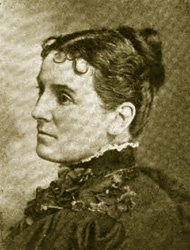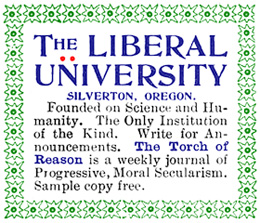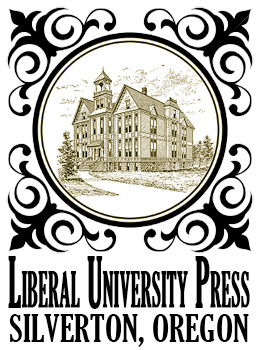By Harriet M. Closz — April, 1901
 Webster City, Iowa: One of the many pagan customs which was abolished during the early years of the Christian era was the cremation of human bodies, and to the belief in the resurrection of the body and in the healing properties of bones and relics of the dead we are indebted for the revival of the unsanitary custom of earth burial.
Webster City, Iowa: One of the many pagan customs which was abolished during the early years of the Christian era was the cremation of human bodies, and to the belief in the resurrection of the body and in the healing properties of bones and relics of the dead we are indebted for the revival of the unsanitary custom of earth burial.
The human family is enslaved by many customs which are a despotic master, but there is no usage so arbitrary, so oppressive as theological tyranny, and it yields its position only to the overwhelming evidence of reason and science.
In the practice of inhumation the processes of nature are retarded from fifteen to sixty years, whereas the same results are accomplished in less than an hour by incineration, and without menace to the health of the living, which medical and mortuary reports tell us surround the “cities of the dead.”
Our cemeteries are, in fact, veritable cities of the dead, for there are about four thousand acres of land in the vicinity of New York City and Brooklyn alone in which there are buried annually 6o,ooo bodies. In six of these cemeteries—none of them over fifty years old—there are buried over 482,000 more persons than are living in Brooklyn to-day. Cobb in his “Earth Burial and Cremation” says that in one township near New York City, there are for every person living, 180 dead bodies buried there. This town contains only 17,000 living inhabitants, and it reports the highest death rate in the State. In some of its most populous acres the dead are placed at the rate of 8,400 per acre.
The Philadelphia Bulletin says, “The dead lie in their graves powerless for good, but they are strong for evil, they pollute the air we breathe and poison the water we drink. Smallpox, typhoid, diphtheria, yellow and scarlet fevers are often caused by the buried.” The experience of Pasteur and Tyndall show that some organisms can be boiled for hours and then frozen, but will survive to propagate their species. A case before the New York Academy of Medicine (1891) shows that a grave digger after having disinterred a diphtheria victim buried twenty-three years soon succumbed to the disease.
Sir Henry Thompson, professor of clinical surgery in the University College of London, says: “No dead body is ever placed in the soil without polluting the earth and the water above and about it.” A prediction was made in 1854 by Sir John Simon of London that cholera would reappear if the excavation of the burial place of plague victims of 1665 was carried on. He predicted truly. After 300 years the European plague at Modena was revived when excavations were made where the victims of the pestilence were buried. Egypt also traces the origin of her plague of 1823 to the opening of a cemetery at Kelioub, near Cairo. In England in 1843, a parish church was being built and the soil spread upon the gardens as a fertilizer and as a result the town was nearly depopulated. Some fifteen years ago an old cemetery of Paris was to be relieved of its occupants that the ground might be converted into a park, which is the history of nearly all city graveyards. The disinterment was begun in the winter and several diggers were stricken with death on the spot. Mr. Eassie tells of Manchester graves that had been dug only a few hours, which had to be chemically ventilated before they could descend into them, as carbonic acid gas had flowed into them from the porous soil adjoining. Dr. F. D. Allen asserts that Trinity churchyard was an active cause of yellow fever in 1822. A century after its establishment disease became so virulent in the vicinity that the burial place was covered with two or three feet of earth and later with fifty-two casks of quicklime, and the stench was so excessive as to cause the workmen to vomit.
At a meeting in St. Louis in 1886 to consider cremation, Dr. J.M. Keller said: “We believe the horrid practice of earth burial does more to propagate the germs of disease and death and to spread desolation and pestilence, than all man’s ingenuity and ignorance in every other custom and habit.
These facts are not denied by the thinking public, but they are listened to with unconcern and apathy and dismissed with a carelessness that amounts to criminal negligence, while with their faces fixed on the “home over there” they overlook the conditions of health here. Our sensibilities are shocked when we read that in one of the London cemeteries the poor are buried in trenches sixty feet long, placed in tiers like brick, 300 coffins in a trench, portions of these trenches being left temporarily open, and the companies claim the right to re-open them in ten years and prepare for another mountain of coffins.
In the burial custom we are behind pagan Japan, for in the city of Tokyo there are cremated annually 10,000 bodies.
In a recent petition to the German Reichstag bearing over 23,000 names asking for a law permitting cremation, only ten names of Protestant ministers appeared. In Portugal violent opposition was made by the clergy, but science prevailed and cremation is now compulsory during epidemics.
The first body cremated in this country was that of Baron de Palm, at Washington, Pa. In 1884 there was but one crematory in the United States, and to F. Julius LeMoine belongs the honor of first introducing the practice in America, but it has grown so in favor that some of the States have appropriated money for the erection of crematories.
The charge for cremation of a body is about $35. The active agent in reducing a body is air, raised to 2,8oo degrees Fahrenheit. The remains do not rest in a flame, nor is there any smoke, odor or noise. The consuming chamber is built of fire clay and capable of resisting the highest temperature. The fire circulates under and around but cannot enter the retort. The heated air soon reduces the form to ashes. A body of 225 pounds can be reduced to five pounds of ashes in fifty-five minutes. It certainly is true that the disposition of the dead by cremation is the most scientific, the most sanitary and the most pleasing of the customs yet practiced by any of the nations of the earth, and I cannot more fittingly close this article than by quoting the consoling words of an eye witness to the cremation of a friend’s body.
“I saw the door of the cinerator taken down, its rosy light shine forth, the form enrobed in white laid there amid a loveliness that was fascinating, and without a glimpse of flames or fire or coals or smoke. I said: ‘This method beyond all is the most pleasing to the senses, the most charming to the imagination and the most grateful to the memory.'”





